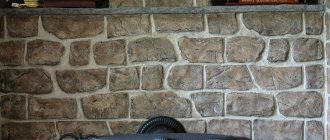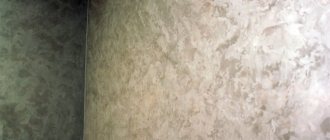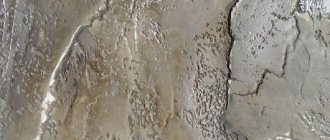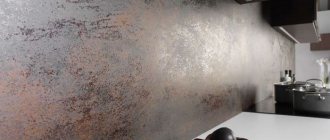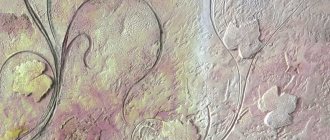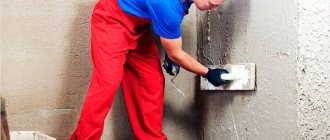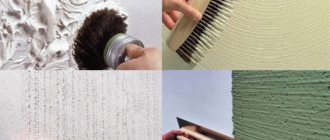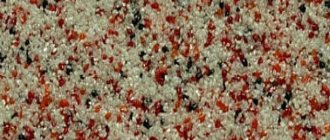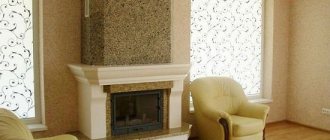Decorative travertine plaster has long been used for interior decoration in order to create a beautiful design that gives the effect of being close to nature. The presented coating option resembles stone, which creates an additional effect of security and durability of the home.
Since the appearance of this material, many ways have appeared to apply it and create a bright image in residential buildings. If you want to create a durable and reliable coating for walls, you should consider the presented option as the main material for repair and finishing work.
What is decorative travertine plaster
Travertine is a decorative plaster, so named because of its resemblance to rock. Typically, rock stone has a pale yellow, beige or gray tint.
A distinctive feature of the material is its porosity, which distinguishes it from most other types of coatings.
Travertine stone has been used since ancient times to decorate building facades, make sculptures, and also for interior decoration. Now manufacturers produce ready-made mixtures with which you can perform finishing work.
Types of application Travertino
Application of travertine in Russia and the world
Limestone tuff has been used for several millennia for the construction of various structures and finishing works. It was especially actively used by ancient Italian architects.
Application in Russia
In Russia, travertine has also been known for a long time and is very popular. It was used in the construction of the Kazan Cathedral, decoration of the Moscow Hotel in St. Petersburg, and cladding of the Vyborgskaya and Ozerki metro stations.” The buildings of the ITAR-TASS information agency, the Izvestia publishing house and many other structures are decorated with limestone tuff.
Application in the world
Famous monuments of Roman architecture are a clear example of how travertine was used in architecture. It was used in the construction of the Colosseum, St. Peter's Basilica in the Vatican, St. Mark's Basilica, the Palace of Justice in Rome, the Trevi Fountain, the Ponte Sant'Angelo and other structures. Today it is used all over the world for exterior and interior decoration of private homes and administrative buildings. For example, in Barcelona, limestone tuff decorates the Lewis Company multi-sports stadium, and in Los Angeles, the Getty Center museum complex.
Features, characteristics and composition
Travertino plaster imitates stone, but it not only creates an external resemblance, but also has a number of advantages.
The finished decorative composition has increased strength, wear resistance, and also exhibits hydrophobic properties.
The classic composition of Travertino plaster includes the following components:
- Fine purified sand.
- Lime with crumbs or dust from mineral elements.
- Binding components to improve adhesion to the wall being treated.
- Decorative fillers.
Varieties of travertine
Travertino plaster can be used to create the interior of an apartment, or for facade work on the outside of a building. For this, different components are used to ensure that resistance to environmental factors is at the required level. So for exterior work you will need a mortar with white cement, for the interior it will be suitable with marble and quartz chips.
Travertino plaster can be used to create the interior of an apartment, or for facade work on the outside of a building.
Silicate mixtures
Modified and acrylic polymers are used for production. It is distinguished by the creation of a layer that allows air to pass through well, allowing the walls to breathe. It also does not crack or change shape over time. It is not subject to the formation of mold and mildew.
It is distinguished by the creation of a layer that allows air to pass through well, allowing the walls to breathe.
Mineral compositions
Often chosen for outdoor work, they can withstand the harsh conditions found outdoors. A durable protective layer is created for the facade. It stands out for its low consumption and high level of adhesion. Suitable for working with cement, gypsum, concrete, plasterboard and chipboard.
Often chosen for outdoor work, they can withstand the harsh conditions found outdoors.
Kinds
Nowadays you can find various types of plaster on store shelves. A large assortment allows you to choose the appropriate room design option, as well as achieve the desired qualities from the coating.
There are silicate and mineral options that differ in composition, basic characteristics and appearance.
To perform the work you will need to prepare the following tools:
- Trowel for smoothing the mixture;
- Construction trowel;
- Rollers with different attachments, brushes of different widths;
- Masking tape;
- Sanding disc for pre-treatment;
- Set of sponges and brushes;
- Rags and personal protective equipment.
Main and auxiliary tools
The layer should be 1-2 millimeters thick to get the desired effect. The average consumption is 1.5-2 kilograms per square meter. The indicator is influenced by the chosen surface treatment method, the type of product and the experience of the craftsman.
Tools used:
- Putty knife;
- Brush;
- Sander;
- Roller;
- Trowel;
- Masking tape.
When working, safety rules are observed; the master must protect himself with special clothing and PPE.
The layer should be 1-2 millimeters thick to get the desired effect.
Surface preparation
The wall must be prepared before starting work; for this purpose, the following must be done:
- The old plaster layer must be removed, and paints, whitewash, decorative elements and other remaining materials must also be removed.
- The surface must be wiped and large particles of dirt and dust removed.
- If mold or fungal colonies appear on the walls, it is worth treating the surface with chlorine-containing substances and then rinsing with a damp cloth.
- Large defects, cracks and chips must be repaired with putty.
- Additionally, to improve adhesion, you can use a primer. To do this, a layer of primer should be applied over the dry wall.
Advantages, disadvantages and properties of plaster
The disadvantages of the material are the complexity of the work; in order for the result to be worthy, it is advisable to contact specialists. Also, the consumption for a better result may become higher, but travertine has more advantages:
- Environmental friendliness;
- High level of strength;
- Resistance to moisture, fire, fungus and mold;
- Beauty of coating;
- Variety of colors;
- Can hide minor flaws;
- Easy to care for the plaster layer.
The disadvantages of the material are the complexity of the work; in order for the result to be worthy, it is advisable to contact specialists.
Application technology
Depending on the characteristics of the rooms and the type of material used, the application technology will differ.
Professionals distinguish between complete or partial application of the composition to the walls, and also note that with the help of a plaster coating you can create a horizontal or vertical pattern.
The presented options for performing the work have their own characteristics, so it is worth taking a closer look at each method of wall finishing.
Continuous application
The presented technique represents the usual distribution of the finished solution over the surface. The mixture is applied to the wall and then smoothed to obtain a small layer 2 mm thick. Using a hard-bristled brush, pores are created in the plaster, imitating real stone. In the final stage, the surface is smoothed with a damp trowel.
Partial application
When choosing the presented option, you will need to apply a primer with quartz filler to the wall. After the primer has dried, a working solution is applied, but it should not be distributed over the entire surface, but into individual areas. The solution is distributed using the “touch-to-touch” method. When the mixture has dried, the plaster is smoothed with a trowel, and then an even texture is given to the wall using sandpaper or a sanding disc.
Horizontal drawing
To create a horizontal pattern, the solution is scooped up using a narrow spatula. The base material is applied to the treated surface. After drying, a level is applied to the wall, along which the sharp corner of the working tool is drawn to remove a strip of plaster mixture.
The next layer can be applied while the top row dries. The mixture that is removed from the wall can be reused. This creates a pattern with horizontal recesses and stripes reminiscent of the relief of natural stone.
Travertine applied in a horizontal pattern
Vertical drawing
The vertical travertine pattern has a similar principle to the horizontal version. In this case, a level or ruler must be applied not horizontally, but vertically to form the corresponding strips on the wall.
Detailed video: horizontal or vertical drawing
Making masonry
Stone masonry is suitable if you want to create a beautiful facade decor. The simplest option for creating a pattern reminiscent of stone laying is to scratch lines using a chisel or the sharp edge of a trowel. To do this, use a ruler to remove the applied mortar from the wall, forming a pattern of masonry.
If desired, you can pre-glue strips of tape to the wall in the vertical and horizontal directions. After the plaster has been applied and dried, the strips can be removed. This will leave a pattern on the wall that resembles masonry.
What's included
Marble chips add texture to the plaster.
Travertine plaster for interior work consists of marble chips, lime and quartz sand. For exterior work, a mixture is made based on white cement and dyes.
Some plasterers try to make a plaster mixture for travertine based on lime or simple putty, adding fillers to them.
But in this way it is quite difficult to create a surface that imitates natural material.
It is better to use ready-made compounds; they are more expensive, but they will pay off in the process of application and operation.
Finish coating
The finished surface already has high strength and withstands mechanical stress well. However, a topcoat may be used to improve performance as well as measure surface color. This type of coating allows you to improve the quality of the material and change its appearance.
Paint, wax or varnish can be used for finishing.
Coloring
If you want to change the color of the coating, you can use paint. There are two main options for painting walls with decorative travertine plaster:
- The first method involves adding color to the finished solution. Tinting is carried out at the preparatory stage, in which the required color is added to the solution, and after that the mixture is applied to the wall. This option is suitable for a small amount of work.
- A more convenient way is to apply paint over the treated surface. Once the wall is completely dry, you can apply a coat of paint using a roller or brush. You can paint the walls with one color, and if you wish, you can create a pattern or use a game of contrast.
Varnishing
Varnishing is used to impart properties such as wear resistance and moisture resistance to the coating.
After applying the varnish, you can care for the walls with a regular damp cloth, which will greatly facilitate the cleaning process. For varnishing, you can use the acrylic version.
It should only be applied to a completely dry coating. Using a wide brush, the composition is applied in thin layers; several layers can be used, with at least 2-4 hours between applications. If you want to create a bright image in the interior, you can add dye or decorative fillers to the varnish.
Waxing (waxing)
Another finishing option is waxing.
The use of wax allows you to achieve the same effect as from applying varnish mixtures. The wax is spread over the wall over the plaster using any available materials.
Apply the composition in a circular motion so that the wax penetrates deep into the travertine. After drying, you can use a rag to remove any remaining mixture and excess marks on the surface.
Additional work
After all the work described above, you can perform some more manipulations or leave everything as it is.
- Grinding. This process produces a glossy surface. It is possible to obtain a stunning effect: the pits remain matte and the bulges remain glossy.
- Coloring. This work is carried out after priming. Paint is applied, after which they take a rag and begin to rub in the applied layer. It turns out that there will be less paint on the surface and more in the depressions.
- Waxing. Wax protects the surface from moisture and extends the life of the decorative finish.
- Varnishing. If surface painting was done, it would be advisable to apply varnish.
Thus, all the work can be done independently if you approach it thoroughly.
Tips and tricks from the experts
Experienced specialists in the field of decoration and renovation share tips when finishing using decorative plaster with travertine effect:
- When tinting the composition, the shade on the wall will be less bright, so before starting work you should try applying the material to the board to determine the shade.
- Using wax, you can fill in the depressions in the material and create a beautiful pattern. To do this, wax with dye or pigment is applied to the holes.
- Additional coating should be applied only after the solution has completely dried, this takes from 1 to 3 days.
- It is best to take extra material to complete the job in one go, otherwise the wall will differ in color.
- Do not forget about safety precautions, especially when performing work on the upper floors.
Variety of textures and reliefs.
Two plastering techniques in the Travertino style.
Existing work schemes: continuous application with subsequent decoration and partial “spraying”. The difference is that the wall can be covered with a network of pits (with continuous application) or tubercles (with partial application).
Continuous coverage.
- Plastering. Thickness: 2-3mm.
It is laid with a spatula, square trowel, grater or even a grater (the latter should not be used immediately, some experience is required).
- Decoration (creating texture). The relief represents differences in the thickness of the plaster.
Photos in the interior
To understand what the façade or interior design of the rooms will look like, it’s worth looking at photo and video materials with options for finished work.
Tyutyunnikov Dmitry
Article verified by a decorative finishing specialist
No. 11. Small decorative elements
Craftsmen can make anything to order. For example, the interior of an apartment can be decorated with a travertine vase, a bowl, or a figurine in the shape of some animal or Greek god. Candlesticks, columns, baseboards and other products for home decoration are made from travertine.
The article was written for the site.
Tags: Decorative stone, Facade

